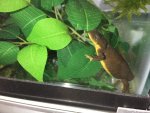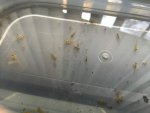Neotenic_Jaymes
Active member
Started laying eggs on January 14th 2015. This group was kept primarily aquatic and cooled at about 40 degrees for 2 months. Once ambient temps transitioned from 40 degrees to about 60 degrees months after the first sighting of amplexus, the female began folding eggs into small leaf plants.The female totally ignored egg laying plastic strips and java moss. Her choice of plant was elodea though she did attempt to lay on plastic and silk plants.
Currently theres well over 100 larvae and going strong. No deaths and just about 100 percent hatch rate of all eggs laid. The female was observed eating some of her own eggs but mostly she left the eggs alone. Enjoy the pics.
Credit also goes to JessKB and Gregarious. Some of these newts were passed around between us in the past year.
Currently theres well over 100 larvae and going strong. No deaths and just about 100 percent hatch rate of all eggs laid. The female was observed eating some of her own eggs but mostly she left the eggs alone. Enjoy the pics.
Credit also goes to JessKB and Gregarious. Some of these newts were passed around between us in the past year.






